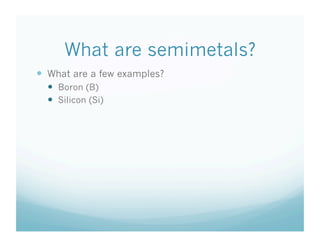What are metals, semimetals, and nonmetals? PDF
- 1. Launch Grab your binder and immediately take a seat Silently study for the quiz
- 2. What are metals, semimetals, and nonmetals? Mr. Heffner 9/21/09
- 3. What are semimetals? Where are they located?
- 4. What are semimetals? What are their properties? Intermediate conductivity Electricity Intermediate melting point Temperature Ice water @ 0°C
- 5. What are semimetals? What are a few examples? Boron (B) Silicon (Si)
- 6. What are metals? Where are they located?
- 7. What are metals? What are their properties? High conductivity High melting point
- 8. What are metals? What are a few examples? Iron (Fe) Gold (Au) Aluminum (Al)
- 9. What are nonmetals? Where are they located?
- 10. What are nonmetals? What are their properties? Low conductivity Low melting point
- 11. What are nonmetals? What are a few examples? Hydrogen (H) Oxygen (O) Neon (Ne)
- 12. Practice Questions 1. Elements can be organized into what three categories? 2. What type of elements border the heavy stepped line? 3. Where are the metals found? The nonmetals? 4. Besides location, how are metals different from nonmetals? 5. Label the following as metal, semimetal, or nonmetal: C, Na, Al, Sb, H, Li, Br, Ba, Si, Hg, & Xe. 6. Would you expect Na to have a low melting point? Why?
- 13. Exit Slip 1. The periodic table is composed of a. two regions: metals and nonmetals. b. two regions: periods and groups. c. three regions: metals, semimetals, and nonmetals. d. three regions: metals, periods, and groups. 2. The region to the right of the heavy stepped line incorporates which of the following? a. metals b. nonmetals c. metals and nonmetals d. all of the semimetals
- 14. Exit Slip 3. Magnesium (Mg) is a a. metal and has a high melting point b. metal and has a low melting point c. nonmetal and has a high melting point d. nonmetal and has a low melting point
- 15. Exit Slip 4. Boron is classified as a ________, meaning it has a(n) ________ conductivity. a. semimetal; intermediate b. semimetal; greater c. metal; greater d. nonmetal; lesser
- 16. Exit Slip 5. What do the elements vandium (V), chromium (Cr), gold (Ag), and silver (Au) have in common? a. They are non-reactive (inert). b. They are nonmetals. c. They have the similar properties for melting point and conductivity. d. They have the same number of neutrons.
- 17. Homework Finish practice questions Start reviewing for Monday’s Unit #2 Exam!
















